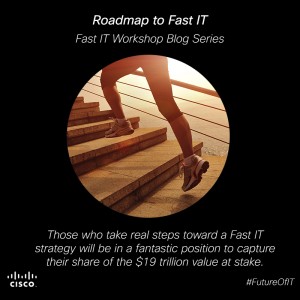































As business leaders navigate an increasingly complex world of connections, they need IT to provide a programmable infrastructure that can dynamically respond to their needs. This four-part blog series explores how responsive infrastructure helps IT leaders succeed. This post will discuss what IT leaders can do now to adopt a roadmap to Fast IT.
To read the first post in this series by Colin Kincaid which introduces Fast IT, a new model for IT, click here. To read the third post in this series by Doug Webster which highlights how service providers specifically stand to benefit from Fast IT, click here. To read the fourth and final post in this series by Jeff Reed which explores how a Fast IT model can mitigate infrastructure challenges, click here.
The old way of doing things won't work anymore for us IT professionals. The "application economy" and explosion of connected devices have increased the complexity of IT to such levels that throwing bodies at the problems won't solve them anymore. The new Fast IT model we discussed in previous blogs enables IT departments to shift focus from spending too much time keeping the lights on to capturing the value of today's connections and preparing for the future.
Here is an example of the CapEx and OpEx savings our own Cisco IT has achieved by following a Fast IT model.

Like any strategic initiative, the transition to a Fast IT model requires careful planning and change management. In particular, organizations need to develop a plan that encompasses people, organizational processes and technologies. Once this foundational plan is in place, CIOs are then ready to begin the steps of preparing their business for Fast IT and building an organization focused on service delivery.
To assist with this process, we've created a four-step roadmap. Here's a closer look at each step:
Step 1: Virtualize your Compute and Storage Infrastructure
The journey to Fast IT requires tight integration among server, network and storage assets. Traditional servers, storage and network silos have been an impediment to speed and innovation. Standardizing and treating your resources as a single, converged infrastructure pool allows dynamic provisioning and faster time to deployment. Virtualization enables IT to provide services that scale seamlessly across a standardized infrastructure. A single-dashboard approach to deploy and operate virtual and physical data center assets, and wired and wireless network infrastructure is essential to deploy new services across the organization. But your infrastructure must be thoughtfully designed to allow bare-metal provisioning while still providing the benefits of virtualization.
Step 2: Get Your Feet Wet with Programmability
In a Software-Defined Architecture, management and control of the networking, storage and data center infrastructure are automated through software rather than by box-by-box components.
Programming network behavior is a valuable capability for every organization, especially as they prepare for Big Data, surging video traffic, Bring-Your-Own-Device (BYOD) environments, and cloud computing. Programmability also allows organizations to dynamically modify infrastructure, making it easier to install and run applications. You can learn more about DevNet, Cisco's newest developer program, here.
Step 3: Develop Increasingly Sophisticated Infrastructure Policies
Making your infrastructure application-aware with centralized automation and policy-driven application profiles delivers software flexibility with the scalability of hardware performance. Through an application-aware approach, organizations can optimize applications and experiences in real-time by defining workflows and policies in advance and across the infrastructure. But you need to start with simple policies that can leverage controllers in your existing environment and build more and more sophisticated templates that can address specific application deployments (SAP Hana for instance) or compliance requirements (for example, HIPAA in the healthcare industry). If you're interested in learning more about an application-aware approach, register for this webinar on Cisco Application-Centric Infrastructure (ACI).
Step 4: Implement a Cloud Strategy for the Intercloud
Because one size does not fit all, a combination of public cloud, private cloud and dedicated servers working together delivers the best results in terms of performance, total cost of ownership (TCO), investment protection, security and compliance. In the Intercloud -a cloud of clouds -organizations can choose where to place workloads based on technical requirements, performance, price, regulations and user expectations. For example, you may choose to use dedicated infrastructure to launch critical new applications while using a public multi-tenant cloud to handle peak traffic.
the Intercloud -a cloud of clouds -organizations can choose where to place workloads based on technical requirements, performance, price, regulations and user expectations. For example, you may choose to use dedicated infrastructure to launch critical new applications while using a public multi-tenant cloud to handle peak traffic.
After completing these four steps, your infrastructure will be simple, smart, secure and ready for Fast IT innovations. Following this type of roadmap can help IT teams be confident in their decisions and help prepare them for the future. Using one of the steps individually -for example, developing a strategy for the Intercloud -is certainly useful. But implementing all four steps together will reduce costs while offering massive growth and innovation opportunities to organizations.
Those who take real steps toward a Fast IT strategy will be in a fantastic position to capture their share of the$19 trillion value at stake over the next decade.
The next post in this blog series will discuss how service providers specifically stand to benefit from Fast IT. Stay tuned!
For more about how to get your business ready for the#FutureOfIT,visit theCisco Executive Perspectives.
Additional Resources:
 Etiquetas calientes:
Cloud computing
Cisco ACI
InternetofEverything
InterCloud
infrastructure programmability
Future of IT
#FutureOfIT
Colin Kincaid
jim grubb
Etiquetas calientes:
Cloud computing
Cisco ACI
InternetofEverything
InterCloud
infrastructure programmability
Future of IT
#FutureOfIT
Colin Kincaid
jim grubb